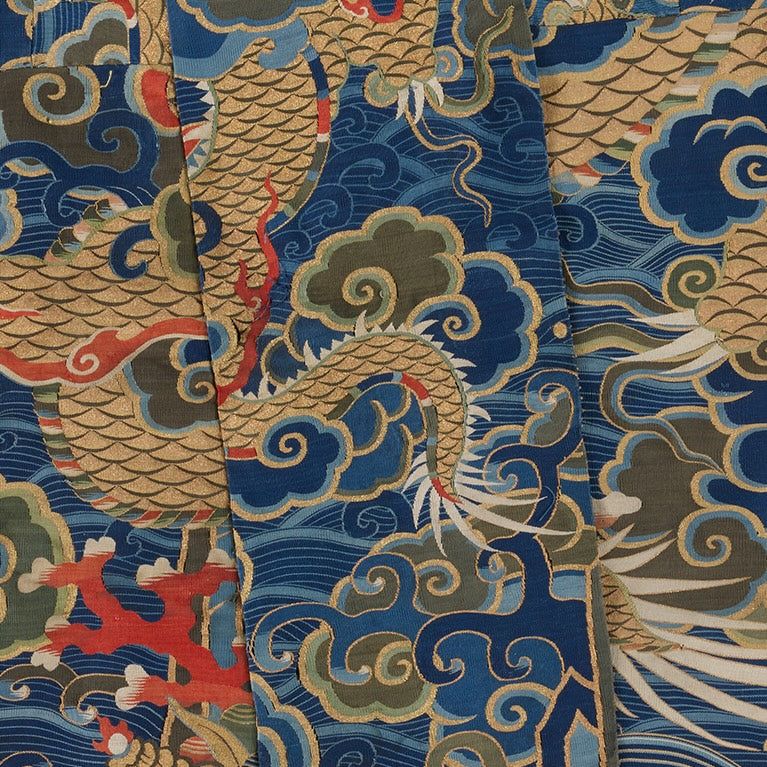
Enduring Traditions: A Century of Textile Stories at The George Washington University Museum
Marking one hundred years since its founding, The Textile Museum at The George Washington University celebrates its centennial with the new exhibition, Enduring Traditions: Celebrating the World of Textiles, on view through December 20, 2025. Gathering together some 60 masterworks from its collection of over 21,000 handmade textiles, the exhibition is both a reflection on a century of collecting and a celebration of the enduring role textiles play in shaping human culture.
 Man's robe, Uzbekistan, 1850-1900. The Textile Museum Collection 2002.5.1. Gift of Caroline McCoy-Jones.
Man's robe, Uzbekistan, 1850-1900. The Textile Museum Collection 2002.5.1. Gift of Caroline McCoy-Jones.
Founded in 1925 by George Hewitt Myers (1875–1957), the museum began in two historic homes in Washington, D.C.’s Kalorama neighborhood. Today, a decade after reopening on GW’s Foggy Bottom campus, the museum continues to explore the artistry and meaning of textiles across five millennia and five continents.
 Kilim, Daghestan. The Textile Museum Collection 2018.12.1. Gift of Bruce P. and Olive W. Baganz.
Kilim, Daghestan. The Textile Museum Collection 2018.12.1. Gift of Bruce P. and Olive W. Baganz.
Across two floors, Enduring Traditions reveals how cloth communicates identity, belief, and belonging. A richly patterned Guatemalan huipil speaks of Mayan heritage; a Nigerian ukara cloth, inscribed with ideographic motifs, encodes messages for an Ezillo men’s society. From an opulent 17th-century Persian carpet to a finely woven Indian wedding saree, textiles here tell stories of status, ceremony, and community. An Uzbek suzani once used in a bride’s trousseau, and festival jackets from southwest China, each evoke the shared rituals that unite generations.
 Tunic, Cameroon, 1900-1925. The Textile Museum Collection 2007.30.3. Donated by Harry and Diane Greenberg.
Tunic, Cameroon, 1900-1925. The Textile Museum Collection 2007.30.3. Donated by Harry and Diane Greenberg.
Religious devotion finds expression too: a miniature Bolivian poncho made for a church statue and a Lao shaman’s shawl woven with protective motifs both hint at the ways textiles mediate between the earthly and spiritual realms. Contemporary perspectives are also woven in, with John Eric Riis’s Congressional Constraint (2012) echoing the form of a 14th-century Chimú tunic, its gold and silk threads reinterpreting ancient opulence as modern political commentary.
 Prayer mat, India, mid-19th century. The Textile Museum Collection 2023.17.1. Roger S. Pratt Collection.
Prayer mat, India, mid-19th century. The Textile Museum Collection 2023.17.1. Roger S. Pratt Collection.
Many of the artworks are displayed alongside images showing how they were originally worn or used, helping visitors to imagine these textiles as living objects integral to daily life, ceremony, and expression. Local voices enrich this connection. Demet Cabbar of Arlington, Virginia, is among several heritage community members invited to share reflections on selected works. Her words accompany a brilliant turquoise Turkish headscarf edged in Oya lace: “Delicately adorned with Oya lace, this handkerchief reminds me of my grandmothers and their sisters, who wove love and devotion into every thread. Once a token of care, a warrior’s adornment, and a symbol of resilience, it carries the whispers of an era when patience was love and effort was its truest expression.”
Printed gallery guides invite visitors to contemplate the exhibition through four themes: Power, Spirituality, Lifestyles, and Community Voices, each offering a lens through which to see the enduring role of textiles in human life. Curated by Sumru Belger Krody, Lee Talbot, and Shelley Burian, Enduring Traditions welcomes viewers to consider how textiles are threads of art, memory, and meaning, and continue to connect us across cultures and centuries.
-
Further Information:
Enduring Traditions: Celebrating the World of Textiles is on through December 2025 at the George Washington University Museum.
George Washington University Museum
-
Image Credits:
Lead: Man's coat, China (Tibet), 17th century. The Textile Museum Collection 2023.18.5. The Myrna and Sam Myers Collection.
All other images as credited in photo captions.
